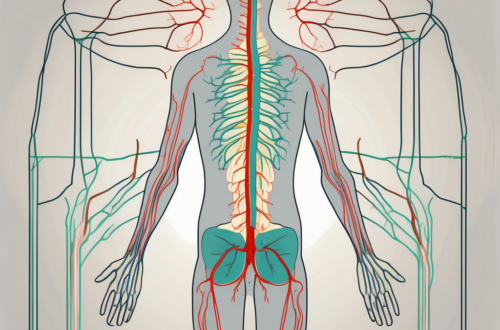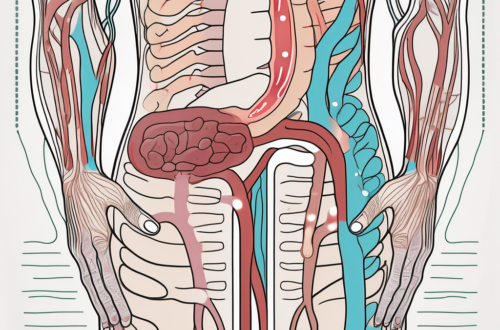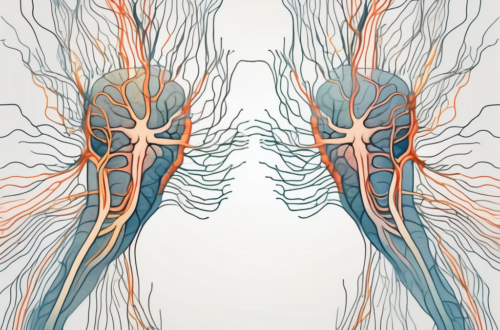The modern world is filled with demands and stressors that can take a toll on our overall well-being. Finding ways to relax and unwind is crucial for our mental health. One effective method is to stimulate the parasympathetic nervous system, which is responsible for promoting relaxation and rest. In this article, we will explore the importance of quick parasympathetic nerve activation, techniques for stimulating this system, and common misconceptions surrounding it.
Understanding the Parasympathetic Nervous System
The parasympathetic nervous system is one of the two main branches of the autonomic nervous system, along with the sympathetic nervous system. While the sympathetic system is responsible for the body’s fight-or-flight response, the parasympathetic system works to counterbalance it and promote relaxation and rest.
The parasympathetic system controls functions such as digestion, heart rate, and blood pressure. When activated, it slows down these bodily processes, allowing the body to enter a state of calm.
But what exactly happens in the body when the parasympathetic nervous system is activated? Let’s delve deeper into the role of this system in promoting relaxation and well-being.
The Role of the Parasympathetic Nervous System in Relaxation
The parasympathetic nervous system plays a pivotal role in helping the body reach a state of relaxation. When activated, it releases neurotransmitters such as acetylcholine, which signal the body to slow down and rest.
Imagine a scenario where you’re sitting in a peaceful garden, surrounded by blooming flowers and the gentle sound of a trickling stream. As you take in the serene environment, your parasympathetic nervous system kicks into gear, promoting a sense of calm and tranquility.
During this state of relaxation, your heart rate decreases, your blood pressure lowers, and your digestive system starts working optimally. It’s as if your body is taking a break from the stresses of daily life, allowing you to recharge and rejuvenate.
But how can we effectively stimulate the parasympathetic system to induce this relaxation response? Let’s explore the science behind parasympathetic nerve activation.
The Science Behind Parasympathetic Nerve Activation
Understanding the science behind parasympathetic nerve activation can provide us with insights on how to effectively stimulate this system. Research has shown that various factors contribute to parasympathetic activation.
One of the most powerful ways to activate the parasympathetic system is through deep breathing exercises. By engaging in diaphragmatic breathing, where you breathe deeply into your abdomen, you can increase respiratory sinus arrhythmia (RSA) – the natural variation in heart rate during breathing cycles. This triggers a relaxation response in the body, activating the parasympathetic system and promoting a state of calm.
But it’s not just breathing exercises that can stimulate the parasympathetic system. Activities like yoga and meditation have also been shown to promote parasympathetic activation. The focused attention and mindful movements characteristic of these practices help shift the body into a relaxed state, allowing the parasympathetic system to take over and restore balance.
So the next time you find yourself feeling stressed or overwhelmed, remember the power of the parasympathetic nervous system. By consciously engaging in relaxation techniques such as deep breathing, yoga, or meditation, you can tap into the inherent ability of your body to promote calmness and well-being.
The Importance of Quick Parasympathetic Nerve Activation
Quick parasympathetic nerve activation is essential for maintaining physical and mental well-being in the face of daily stressors. By consciously stimulating the parasympathetic system, we can reap numerous benefits.
The parasympathetic nervous system is responsible for the body’s rest and digest response. It helps to counterbalance the sympathetic nervous system, which is responsible for the fight-or-flight response. When the parasympathetic system is activated, it promotes a state of relaxation and calmness, allowing the body to recover and rejuvenate.
One way to activate the parasympathetic system is through deep breathing exercises. By taking slow, deep breaths and focusing on the breath, we can signal to the body that it is safe to relax. This activates the parasympathetic system and helps to reduce stress and promote overall well-being.
Health Benefits of Rapid Relaxation Response
A rapid relaxation response induced by parasympathetic nerve activation can have significant health benefits. Studies have found that activating the parasympathetic system can help reduce blood pressure, lower heart rate, and enhance digestion.
When the parasympathetic system is activated, blood vessels relax, allowing for improved blood flow and lower blood pressure. This can have a positive impact on cardiovascular health and reduce the risk of heart disease.
In addition, promoting relaxation through parasympathetic stimulation may contribute to improved sleep, reduced muscle tension, and decreased levels of stress hormones. These benefits can collectively enhance overall well-being and quality of life.
Furthermore, activating the parasympathetic system can support the body’s immune system. Chronic stress and a constantly activated sympathetic system can weaken the immune response, making us more susceptible to illnesses. By promoting relaxation and activating the parasympathetic system, we can strengthen our immune system and improve our ability to fight off infections.
The Impact on Stress and Anxiety
Stress and anxiety are prevalent in today’s society, and finding effective ways to manage them is crucial. Quick parasympathetic nerve activation can serve as a powerful tool in combating stress and anxiety.
By actively engaging the parasympathetic system, we can counteract the heightened state of arousal caused by stress. This can lead to a calmer mind, improved mood, and a greater sense of control over stressful situations.
Moreover, activating the parasympathetic system can help regulate the body’s stress response. It can reduce the production of stress hormones like cortisol and adrenaline, which can have detrimental effects on both physical and mental health when constantly elevated.
However, it’s important to note that while parasympathetic nerve activation techniques can be beneficial, they should not replace professional advice or treatment for chronic stress or anxiety disorders. Consulting with a healthcare professional is always advisable.
In conclusion, quick parasympathetic nerve activation plays a crucial role in maintaining overall well-being and managing stress and anxiety. By incorporating techniques that stimulate the parasympathetic system into our daily lives, we can experience numerous health benefits and improve our quality of life.
Techniques for Stimulating the Parasympathetic Nervous System
Fortunately, there are several techniques that can help stimulate the parasympathetic nervous system and promote rapid relaxation. These techniques are simple and can be incorporated into your daily routine.
The parasympathetic nervous system is responsible for the body’s rest and digest response. When activated, it helps to calm the mind, reduce stress, and promote a state of relaxation throughout the body.
Breathing Exercises for Parasympathetic Activation
One of the most accessible ways to activate the parasympathetic system is through deep breathing exercises. Diaphragmatic breathing, also known as belly breathing, involves inhaling deeply through the nose, allowing your abdomen to expand, and exhaling slowly through pursed lips.
Engaging in deep breathing for a few minutes each day can help calm the mind, reduce stress, and promote relaxation throughout the body. It allows for increased oxygen intake, which in turn helps to slow down the heart rate and lower blood pressure.
Additionally, deep breathing exercises can help to release tension in the muscles, improve digestion, and enhance overall well-being.
Yoga and Meditation for Relaxation Response
Practices such as yoga and meditation can be invaluable tools for stimulating the parasympathetic system. These practices involve focused attention on the breath, gentle movement, and inner reflection, all of which contribute to relaxation and stress reduction.
Yoga combines physical postures, breathing techniques, and meditation to promote a state of calm and balance. It helps to release tension in the body, increase flexibility, and improve overall body awareness.
Meditation, on the other hand, involves focusing the mind and redirecting thoughts to achieve a state of mental clarity and relaxation. It can be done in various forms, such as mindfulness meditation, loving-kindness meditation, or transcendental meditation.
Even dedicating a few minutes each day to a yoga or meditation practice can have a profound impact on stimulating the parasympathetic nervous system and promoting relaxation. These practices not only help to reduce stress and anxiety but also improve mood, enhance cognitive function, and boost overall well-being.
By incorporating deep breathing exercises, yoga, and meditation into your daily routine, you can effectively stimulate the parasympathetic nervous system and experience the numerous benefits of relaxation and stress reduction.
Dietary Influence on Parasympathetic Nerve Activation
The saying “you are what you eat” holds true when it comes to parasympathetic nerve activation. The foods we consume can influence our overall nervous system health and, consequently, our ability to relax.
When it comes to promoting relaxation and supporting parasympathetic nerve activation, certain foods can play a significant role. Incorporating these foods into your diet can help you achieve a more relaxed state and enhance your overall well-being.
Foods That Promote Relaxation Response
Incorporating certain foods into your diet can support parasympathetic nerve activation and relaxation. Foods rich in omega-3 fatty acids, such as fatty fish and flaxseeds, have been found to have a calming effect on the nervous system. These healthy fats not only provide essential nutrients but also help reduce inflammation in the body, promoting a sense of tranquility.
Additionally, foods like nuts, seeds, and dark chocolate contain magnesium, which is known to help the body relax and promote a sense of calmness. Magnesium plays a crucial role in regulating neurotransmitters and muscle function, making it an essential mineral for maintaining a healthy nervous system.
It’s important to note that while certain foods may support relaxation, a well-balanced diet overall is essential for optimal nervous system function. Including a variety of fruits, vegetables, whole grains, and lean proteins in your meals can provide the necessary nutrients for a healthy parasympathetic response. Consulting a healthcare professional or registered dietitian for personalized advice is recommended.
The Role of Hydration in Nerve Activation
Proper hydration is often overlooked but plays a vital role in maintaining optimal nervous system function, including parasympathetic activation. Water is the foundation of life, and its importance cannot be overstated.
Dehydration can increase stress on the body and lead to heightened sympathetic activity. When we are dehydrated, our body’s ability to function optimally is compromised, and this can negatively impact our ability to relax and activate the parasympathetic nervous system.
By ensuring adequate hydration through the consumption of water and hydrating foods, we can support the parasympathetic system and promote relaxation. Drinking enough water throughout the day helps maintain the balance of bodily fluids, aids in digestion, and supports the transportation of nutrients to the cells, all of which contribute to a healthy nervous system.
In addition to water, consuming hydrating foods such as fruits and vegetables can also contribute to overall hydration levels. These foods are not only rich in water content but also provide essential vitamins, minerals, and antioxidants that support nervous system health.
In conclusion, the foods we eat and our hydration levels can significantly influence parasympathetic nerve activation and our ability to relax. By incorporating foods rich in omega-3 fatty acids and magnesium into our diet, as well as maintaining proper hydration, we can support a healthy parasympathetic response and promote overall well-being.
Common Misconceptions about Parasympathetic Nerve Activation
In the pursuit of quick relaxation, there are several misconceptions surrounding parasympathetic nerve activation that deserve clarification.
Parasympathetic nerve activation is a vital aspect of our body’s response to stress and plays a significant role in promoting relaxation and restoring balance. However, there are certain myths and misunderstandings that need to be debunked to have a better understanding of this process.
Debunking Myths about Quick Relaxation Techniques
One common myth is that quick relaxation techniques should always provide immediate results. While some techniques may provide immediate relief, others may require consistent practice to yield significant benefits.
It’s important to remember that our bodies are complex systems, and achieving deep relaxation may take time and patience. Quick techniques can be helpful in certain situations, but it’s equally important to explore and incorporate long-term practices that promote sustained relaxation.
Additionally, it’s important to recognize that quick parasympathetic nerve activation techniques may not work for everyone. Each individual has unique needs and responses, and it’s essential to find techniques that resonate with you personally.
Experimenting with different relaxation techniques, such as deep breathing exercises, progressive muscle relaxation, or guided imagery, can help you discover what works best for you. It’s a journey of self-discovery and finding the techniques that align with your preferences and lifestyle.
Understanding the Limitations of Parasympathetic Activation
Parasympathetic nerve activation is undoubtedly beneficial, but it’s crucial to understand that it is not a cure-all for all health conditions or chronic illnesses.
While stress management techniques involving parasympathetic activation can help alleviate symptoms and support overall well-being, they should complement, not replace, medical treatment. Consulting with a healthcare professional is essential, especially for individuals with pre-existing medical conditions or mental health concerns.
It’s important to view parasympathetic nerve activation as a valuable tool in managing stress and promoting relaxation, but it should be integrated into a comprehensive approach to health and well-being. This may include a combination of medical treatment, therapy, healthy lifestyle choices, and other stress management techniques.
By understanding the limitations of parasympathetic activation and seeking professional guidance when needed, individuals can make informed decisions about their well-being and develop a holistic approach to managing stress and achieving relaxation.
Maintaining a Balanced Nervous System
While stimulating the parasympathetic nervous system is crucial for relaxation, maintaining a balanced nervous system requires awareness of the interplay between the parasympathetic and sympathetic systems.
The parasympathetic and sympathetic systems work in harmony, each playing a vital role in maintaining physiological balance. The sympathetic system prepares the body for action, activating the fight-or-flight response when faced with a perceived threat. On the other hand, the parasympathetic system restores calm and promotes relaxation, allowing the body to rest and recover.
Achieving balance involves recognizing when sustained sympathetic activation is necessary, such as during physical exertion or in response to a life-threatening situation. It is crucial to allow these fluctuations in the autonomic nervous system to occur naturally, as they are essential for our survival and overall well-being.
However, in today’s fast-paced and stressful world, many individuals find themselves in a constant state of sympathetic dominance. This chronic activation can lead to various health issues, including high blood pressure, insomnia, and digestive problems.
The Interplay Between Sympathetic and Parasympathetic Systems
Understanding the interplay between the sympathetic and parasympathetic systems is key to maintaining a balanced nervous system. When faced with a stressful situation, the sympathetic system activates, releasing stress hormones like adrenaline and cortisol. These hormones increase heart rate, blood pressure, and alertness, preparing the body to fight or flee.
Once the threat has passed, the parasympathetic system takes over, initiating the relaxation response. It slows down heart rate, lowers blood pressure, and promotes digestion and healing. This balance between the two systems is crucial for our overall health and well-being.
However, chronic stress can disrupt this delicate balance, leading to an overactive sympathetic system and an underactive parasympathetic system. This imbalance can have detrimental effects on our physical and mental health, contributing to conditions such as anxiety, depression, and chronic fatigue.
Therefore, it is essential to find ways to activate the parasympathetic system and promote relaxation regularly. Engaging in activities such as deep breathing exercises, meditation, yoga, and spending time in nature can help stimulate the parasympathetic nervous system and restore balance.
Tips for Long-Term Nervous System Health
Maintaining long-term nervous system health requires consistent effort and attention. Engaging in regular physical activity is one of the most effective ways to support a balanced nervous system. Exercise not only helps reduce stress and anxiety but also promotes the release of endorphins, which are natural mood boosters.
Incorporating stress management techniques into your daily routine is also crucial. This can include practices such as mindfulness meditation, journaling, or engaging in hobbies that bring you joy and relaxation. Finding healthy ways to cope with stress can significantly impact your nervous system’s overall health and resilience.
Additionally, prioritizing self-care is essential for maintaining a balanced nervous system. This can involve setting boundaries, practicing self-compassion, and ensuring you get enough restful sleep each night. Taking time for yourself and engaging in activities that bring you joy and relaxation can help recharge your nervous system and improve your overall well-being.
Seeking support from healthcare professionals, such as doctors or therapists, can provide valuable guidance and personalized recommendations for maintaining a healthy nervous system. They can help identify any underlying issues or imbalances and provide appropriate treatment options to support your nervous system’s health.
In conclusion, maintaining a balanced nervous system is crucial for our overall health and well-being. By understanding the interplay between the sympathetic and parasympathetic systems, incorporating stress management techniques, and prioritizing self-care, we can foster a healthy and resilient nervous system. Taking proactive steps to support our nervous system health can lead to improved physical and mental well-being, allowing us to live a more balanced and fulfilling life.





